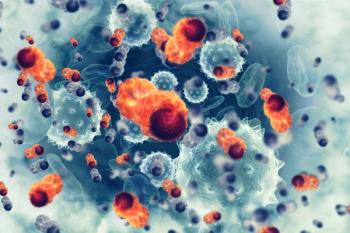
Oncology NEWS International
- Oncology NEWS International Vol 6 No 12
- Volume 6
- Issue 12
Modulators of FUDR May Improve Outcomes in Patients Receiving Hepatic Artery Infusion
CHICAGO-Hepatic artery infusion of fluorodeoxyuridine (floxuridine or FUDR) theoretically should benefit colorectal cancer patients with metastases in the liver because it delivers chemotherapy directly into the tumors. This not only raises intratumoral drug levels but also prolongs the duration of exposure of the tumors to chemotherapy without increasing toxicity.
CHICAGOHepatic artery infusion of fluorodeoxyuridine (floxuridine or FUDR) theoretically should benefit colorectal cancer patients with metastases in the liver because it delivers chemotherapy directly into the tumors. This not only raises intratumoral drug levels but also prolongs the duration of exposure of the tumors to chemotherapy without increasing toxicity.
In prospective randomized trials in the 1980s, however, hepatic artery infusion not only failed to improve survival, it also frequently caused toxic complications such as biliary sclerosis.
Now, researchers may have found ways of improving survival and reducing the toxic complications of hepatic artery infusion by manipulating the dose and duration of FUDR or by using FUDR in combination with other drugs that modulate its actions, said Mark Talamonti, MD, assistant professor of surgery, Lurie Cancer Center, Northwestern University, at the annual scientific meeting of the American College of Surgeons.
He described four phase II trials using these new approaches. In one study at the University of California, San Francisco, in 1991, the dose and duration of FUDR were reduced. Rather than two 14-day courses of chemotherapy at doses of FUDR as high as 0.3 mg/kg/day, the investigators gave 0.1 mg/kg/day of FUDR for 7 days, followed by a bolus injection of fluorouracil on days 15, 22, and 29.
In two studies at Memorial Sloan Kettering Cancer Center, the actions of FUDR were modulated by adding other agents to the regimen. In one study, researchers mediated the inflammatory response to FUDR by administering dexamethasone; in the other, the cytotoxicity of the drug was enhanced by giving leucovorin as a potentiator.
Preliminary results from these trials were so good, the researchers initiated another trial in which FUDR, dexametha-sone, and leucovorin were combined, Dr. Talamonti said. The three-drug combination produced response rates of at least 78%, increased median survival up to 2 years, and caused only a 3% rate of biliary sclerosis.
These studies have led to a Cancer and Leukemia Group B (CALGB) trial that is comparing survival, response rates, patient tolerance, cost effectiveness, and toxicity of hepatic artery infusion and systemic chemotherapy.
In the CALGB trial, all patients in the experimental group receive FUDR, dex-amethasone, and leucovorin for 14 days, and the cycle is repeated every 28 days. These patients are compared with a control group treated with IV bolus fluorouracil. Hopefully, weve got the right study, the right drugs, and well get the right answer, Dr. Talamonti said.
Articles in this issue
about 28 years ago
Team-Based Approach to Managed Specialty Careabout 28 years ago
Children’s Art Project at M.D. Andersonabout 28 years ago
Office of Cancer Survivorship Grants Awards for First 20 Studiesabout 28 years ago
Laparoscopic Colectomy May Prove Equivalent to Open Surgeryabout 28 years ago
Advice on Negotiating BMT Service Contractsabout 28 years ago
Komen Debuts New Websites on Breast Cancerabout 28 years ago
‘MDs Too Often Fail to Give Adequate Analgesic Doses’about 28 years ago
Breach of Fiduciary Duty-How to Defend Against Itabout 28 years ago
Survivors Help Women Deal With Breast Cancer Diagnosisabout 28 years ago
University of Utah’s Huntsman Cancer Institute Joins NCCNNewsletter
Stay up to date on recent advances in the multidisciplinary approach to cancer.
















































































